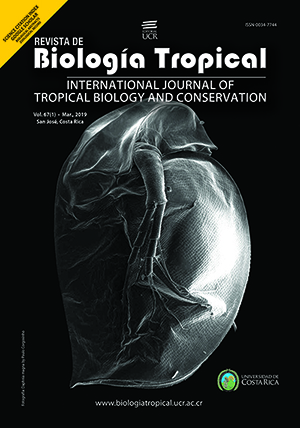Abstract
The access to updated data on the names of the crustacean species and their distribution in a given area is a first step to evaluate changes due to local, regional and global factors such as overfishing, pollution, and climatic change. Data in this study are based on the expeditions of the RV Skimmer (20 stations, 1978-1980) and RV Victor Hensen (1992-1994, 12 stations) in the Gulf of Nicoya estuary. The crustaceans were collected by means of an Otter trawl (Skimmer, mesh 3.5 cm) and by Otter and Beam trawls (V. Hensen, mesh 2.5 cm and 1.0 cm, respectively) at depths from 10 m to 228 m. Data from two later studies were also included, one from an intertidal flat in the upper Gulf and the other from stations at the mouth of the estuary, which expand the depth range from 0 to 350 m. The list of species in the original publications were reviewed and 32 corrections were made based on recent literature and the web page, World Register of Marine Species (WORMS). The total number of species for both surveys was 131, of which 119 were decapods and 12 were stomatopods. Data from the other two studies and from the crustacean collection deposited at the University of Costa Rica Zoology Museum added 43 records for a total of 174 species collected in sediments from the estuary. For the Skimmer, the minimum number of species found in one station was four (three stations) and the maximum was 27, with an average of 12.3 species / station. For the V. Hensen, the minimum of species found in one station was eight, with a maximm of 27 and an average of 17 species / station. The species present in 50 % or more of the 20 stations of the Skimmer expedition, were: Callinectes arcuatus, Rimapenaeus faoea, Penaeus brevirostris, Achelous asper and Hepatus kossmanni. For the V. Hensen expedition, the species present in 50 % or more of the 12 stations, were: A. asper, Sicyonia disdorsalis, S. picta, and Persephona subovata. During the Skimmer survey a total of 15 species were found at only one station, while for the V. Hensen the number was 26. Two presence-absence matrices based on the updated names of the crustaceans collected by the Skimmer (57 species x 20 stations) and V. Hensen (82 species x 12 stations) were analyzed by Non Metric Dimensional Scaling (NMDS) to display the distribution of stations in a two-dimensional space. The results revealed heterogeneous groups of stations. Several sub-groups of two or three stations agreed with their geographical proximity. The four V. Hensen stations, located at the mouth of the estuary at depths greater than 100 m, were separated more clearly from the others and may indicate a transition, from estuarine to deep waters, in the composition of the crustacean fauna. Future evaluations of the crustacean diversity of the Gulf of Nicoya must take into account the wide spatial distribution of some species and the patchy distribution of others. Temporal variability is also important in the estuary as evidenced by the population oscilallations of Pinnixulala valeri over a three year period.
##plugins.facebook.comentarios##

This work is licensed under a Creative Commons Attribution 4.0 International License.
Copyright (c) 2019 Jose Vargas Zamora






